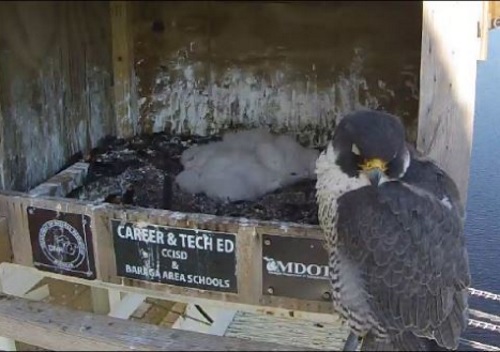Several state departments of transportation are helping bring back the Peregrine falcon from the brink of extinction by providing nesting platforms on bridges – creating a true symbiotic relationship that protects bird and bridge.
[Photo by Michigan DOT.]
By the 1970s, Peregrine falcon populations were nearly wiped out in the United States, partly because of the widespread use of the pesticide dichloro-diphenyl-trichloroethane – more commonly known as DDT – made the falcons’ eggshells too brittle. The ban of DDT helped to re-establish the falcons, which prefer to lay their eggs on ledges at high altitudes.
Meanwhile, state DOTs across the U.S. were battling the corrosive effects of pigeon guano, which can eat away at the concrete and steel on bridges as well as pose cleanup hazards for work crews.
Enter the falcon, which loves to feast on pigeons – or at the very least scare them away.
The Michigan Department of Transportation is one of several DOTs that encourage falcons to nest under their bridges. In 2010, the Michigan DOT placed a simple wooden platform on the Sault Ste. Marie International Bridge across the St. Mary’s River to provide the birds a safe nesting place, according to Dan Weingarten with Michigan DOT’s Office of Communications. So far, the platform has been home for 30 falcon chicks that have hatched, helping locally re-establish the species.
[Editor’s note: You can view a live camera feed of the falcons by clicking here.]
The platform is a win-win for MDOT, which does not want the pigeons and their acidic droppings, and the falcons, who need a high-altitude home for nesting and hunting.
“One of the reasons it seemed like a good fit is they would prey on or scare away the pigeons,” Weingarten said. “It seems to have worked. The pigeons at least moved.”

In 2013, the Michigan DOT installed two more platforms at the Portage Lake Lift Bridge that have produced 24 chicks. Crews have since relocated those boxes to other locations because of bridge repair work, but many other states have active falcon nesting programs on their bridges.
One of the first states to get into the falcon platform business was Virginia, which placed a nesting box on the Coleman Bridge in the early 1990s. Since then, the Virginia Department of Transportation has placed several more platforms on other bridges – work that greatly benefits the falcon population, according to a report from The Center for Conservation Biology.
“Bridges have made a significant contribution to the Virginia peregrine falcon population,” supporting more than 30 percent of the known falcon population in the state, the report noted.
Other states – including Connecticut, Massachusetts, New Jersey, New York, and Ohio – also have built and installed platforms to welcome the peregrine falcon to nest in their bridges. “Infrastructure is a small part of the comeback story of these birds,” Michigan DOT’s Weingarten said. “But it’s definitely played a role in re-establishing them.”

